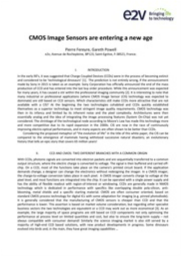CMOS Image Sensors are entering a new age
In the early 90's, it was suggested that Charge Coupled Devices (CCDs) were in the process of becoming extinct and considered to be ‘technological dinosaurs'. The prediction is not entirely wrong, if the announcement made by Sony in 2015 is taken as an example.
Sony Corporation has officially announced the end of the mass production of CCD and has entered into the last buy order procedure. While this announcement was expected for many years, it has caused a stir within the professional imaging community.
Download this whitepaper to learn more.
Read More
By submitting this form you agree to Teledyne e2v contacting you with marketing-related emails or by telephone. You may unsubscribe at any time. Teledyne e2v web sites and communications are subject to their Privacy Notice.
By requesting this resource you agree to our terms of use. All data is protected by our Privacy Notice. If you have any further questions please email dataprotection@techpublishhub.com
Related Categories: Cooling and Thermal Management, Electromechanical, Enclosures, HVAC, Motors and Drives, Relays, Sensors, Switches, Tranducers


More resources from Teledyne e2v

CCD QE in the Soft X-ray Range
e2v has previously provided back-illuminated CCDs for several solar observation projects, resulting in a number of key articles on CCD QE in the so...

Ultra-Low Dark Signal in the AIMO CCD230-84
CCDs are ideal for very low light imaging applications, such as astronomy, clinical diagnostic testing, and bioluminescence. The compatibility of t...

Freeing high speed CMOS line scan cameras from the frame grabber
For some decades now, line scan cameras based on just one or two lines of pixel sensors have become well established in machine vision applications...
